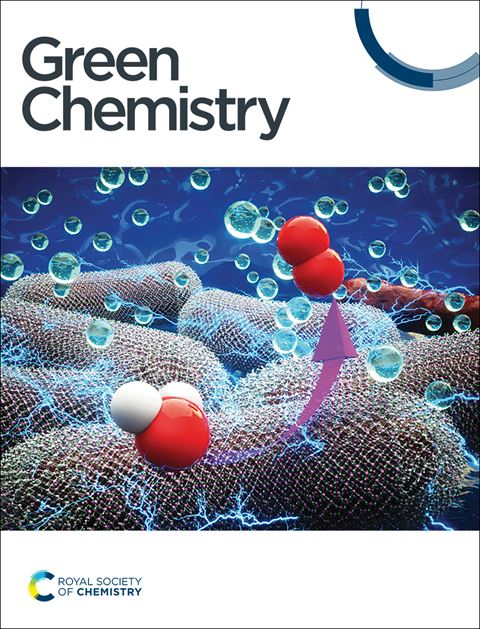Enhancing the selectivity of C2 hydrocarbons over Fe-based catalysts by controlling nitrogen doping in electrocatalytic CO2 reduction†
IF 9.3
1区 化学
Q1 CHEMISTRY, MULTIDISCIPLINARY
引用次数: 0
Abstract
Rational design of cost-effective materials as highly efficient catalysts for the electrochemical CO2 reduction reaction (CO2RR) to produce multi-carbon (C2+) hydrocarbons is highly desirable. Cu-based catalysts are widely recognized as effective for the electrosynthesis of multi-carbon products. Exploration of non-copper-based catalysts for C2+ products is very interesting and challenging. In this work, using ethylenediaminetetraacetic acid disodium salt and ethylenediamine as the ligands and N source, N-doped Fe2O3 catalysts containing FeO1−xNx (0.34 < x < 0.54) sites with and without a FeN4 structure were fabricated. It was found that the catalyst without a FeN4 structure converted CO2 to C2 hydrocarbons (ethane and ethylene). The faradaic efficiency (FE) of C2 products and the current density of C2 products reached 60.8% and 39.1 mA cm−2, respectively, which is currently the best result for non-copper catalysts in an H-cell. However, the FE of the catalyst with a FeN4 structure was much lower when producing C2 products. Detailed study showed that the FeO1−xNx sites with suitable coordination of N with Fe was pivotal to the high FE of C2 products. A combination of experimental and density functional theory studies indicated that the feasible coordination of N with Fe resulted in the deformation of the electron cloud around the Fe nucleus, which facilitated the charge transfer and promoted the production of C2 products. This work provides a successful example of designing non-copper catalysts for producing C2+ products in the CO2RR.
求助全文
约1分钟内获得全文
求助全文
来源期刊

Green Chemistry
化学-化学综合
CiteScore
16.10
自引率
7.10%
发文量
677
审稿时长
1.4 months
期刊介绍:
Green Chemistry is a journal that provides a unique forum for the publication of innovative research on the development of alternative green and sustainable technologies. The scope of Green Chemistry is based on the definition proposed by Anastas and Warner (Green Chemistry: Theory and Practice, P T Anastas and J C Warner, Oxford University Press, Oxford, 1998), which defines green chemistry as the utilisation of a set of principles that reduces or eliminates the use or generation of hazardous substances in the design, manufacture and application of chemical products. Green Chemistry aims to reduce the environmental impact of the chemical enterprise by developing a technology base that is inherently non-toxic to living things and the environment. The journal welcomes submissions on all aspects of research relating to this endeavor and publishes original and significant cutting-edge research that is likely to be of wide general appeal. For a work to be published, it must present a significant advance in green chemistry, including a comparison with existing methods and a demonstration of advantages over those methods.
 求助内容:
求助内容: 应助结果提醒方式:
应助结果提醒方式:


